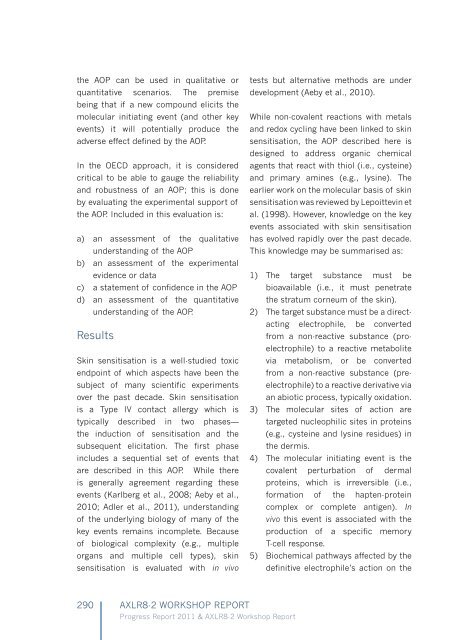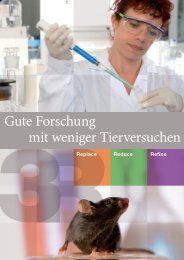You also want an ePaper? Increase the reach of your titles
YUMPU automatically turns print PDFs into web optimized ePapers that Google loves.
the AOP can be used in qualitative or<br />
quantitative scenarios. The premise<br />
being that if a new compound elicits the<br />
molecular initiating event (and other key<br />
events) it will potentially produce the<br />
adverse effect defined by the AOP.<br />
In the OECD approach, it is considered<br />
critical to be able to gauge the reliability<br />
and robustness of an AOP; this is done<br />
by evaluating the experimental support of<br />
the AOP. Included in this evaluation is:<br />
a) an assessment of the qualitative<br />
understanding of the AOP<br />
b) an assessment of the experimental<br />
evidence or data<br />
c) a statement of confidence in the AOP<br />
d) an assessment of the quantitative<br />
understanding of the AOP.<br />
Results<br />
Skin sensitisation is a well-studied toxic<br />
endpoint of which aspects have been the<br />
subject of many scientific experiments<br />
over the past decade. Skin sensitisation<br />
is a Type IV contact allergy which is<br />
typically described in two phases—<br />
the induction of sensitisation and the<br />
subsequent elicitation. The first phase<br />
includes a sequential set of events that<br />
are described in this AOP. While there<br />
is generally agreement regarding these<br />
events (Karlberg et al., 2008; Aeby et al.,<br />
2010; Adler et al., 2011), understanding<br />
of the underlying biology of many of the<br />
key events remains incomplete. Because<br />
of biological complexity (e.g., multiple<br />
organs and multiple cell types), skin<br />
sensitisation is evaluated with in vivo<br />
tests but alternative methods are under<br />
development (Aeby et al., 2010).<br />
While non-covalent reactions with metals<br />
and redox cycling have been linked to skin<br />
sensitisation, the AOP described here is<br />
designed to address organic chemical<br />
agents that react with thiol (i.e., cysteine)<br />
and primary amines (e.g., lysine). The<br />
earlier work on the molecular basis of skin<br />
sensitisation was reviewed by Lepoittevin et<br />
al. (1998). However, knowledge on the key<br />
events associated with skin sensitisation<br />
has evolved rapidly over the past decade.<br />
This knowledge may be summarised as:<br />
1) The target substance must be<br />
bioavailable (i.e., it must penetrate<br />
the stratum corneum of the skin).<br />
2) The target substance must be a directacting<br />
electrophile, be converted<br />
from a non-reactive substance (proelectrophile)<br />
to a reactive metabolite<br />
via metabolism, or be converted<br />
from a non-reactive substance (preelectrophile)<br />
to a reactive derivative via<br />
an abiotic process, typically oxidation.<br />
3) The molecular sites of action are<br />
targeted nucleophilic sites in proteins<br />
(e.g., cysteine and lysine residues) in<br />
the dermis.<br />
4) The molecular initiating event is the<br />
covalent perturbation of dermal<br />
proteins, which is irreversible (i.e.,<br />
formation of the hapten-protein<br />
complex or complete antigen). In<br />
vivo this event is associated with the<br />
production of a specific memory<br />
T-cell response.<br />
5) Biochemical pathways affected by the<br />
definitive electrophile’s action on the<br />
290<br />
AXLR8-2 WORKSHOP REPORT<br />
Progress Report 2011 & AXLR8-2 Workshop Report




